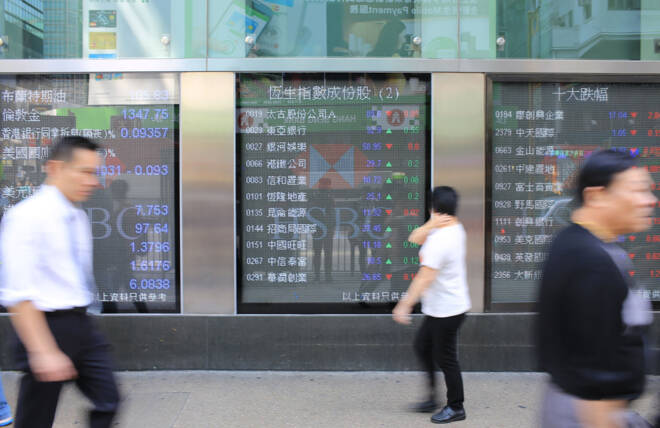Advertisement
Advertisement
Hang Seng Index News: Tariff Jitters and Weak PMIs Fuel Price Pressures
By:
Key Points:
- Hang Seng Index drops 1.89% as Trump tariff threats and weak China PMIs weigh on market sentiment.
- Trump accuses China of breaking trade truce by delaying rare earth exports, escalating tensions.
- Tech and EV stocks tumble; Alibaba, Baidu, BYD, and Li Auto post heavy losses on June 2 open.
Tariff Threats: Trump Accusations Impact Sentiment, Bears Target 23,000 Break
Rising trade tensions impacted demand for Hong Kong-listed stocks on Monday, June 2. The Hang Seng Index extended its losses from May 30 in early trading. This pressured tech and EV stocks, dragging the index into negative territory.
Market focus now turns to trade headlines, upcoming Chinese PMI data (due June 3 and 5), and potential stimulus pledges from Beijing if US-China relations deteriorate. These factors could dictate whether the index drops toward 22,000 or rebounds toward the 24,000 handle.
Hong Kong Stocks Stumble as Trade War Intensifies
While US equity markets posted mixed performance on May 30— with the Nasdaq Composite Index down 0.32% and the Dow up 0.13%— US-China trade war jitters impacted risk sentiment. Trump raised steel levies from 25% to 50%, adding to market unease. Disappointing private sector PMI data from China from the weekend also influenced risk sentiment. The Hang Seng Index dropped 1.89% to 22,849 in early trading on June 2. Mainland China’s markets were closed for the Duanwu Festival.
Tech Stocks Slide; EV Sector Tumbles
The Hang Seng Tech Index fell 1.42% as investors considered the threat of more tariffs and tech-related restrictions. Tech heavyweights Alibaba (9988) and Baidu (9888) declined 1.76% and 1.59%, respectively. The US government’s recent suspension of chip software exports to China continued to affect investor sentiment.
EV stocks posted heavier losses at the start of the week. BYD (1211) slid 3.67% while Li Auto (2015) declined 3.56%.
Trump Accuses China of Breaking Trade Truce
On May 30, President Trump accused China of breaking the 90-day trade war truce by delaying exports of rare earth minerals to the US. Rare earth minerals are vital components in electric vehicles and high-tech manufacturing. Following last week’s court rulings on Trump’s Liberation Day tariffs, speculation intensified over potential additional tariffs. Wall Street Journal Chief Economics Correspondent Nick Timiraos remarked:
“The White House is considering a stopgap effort to impose tariffs on swaths of the global economy under a never-before-used provision, Section 122, of the Trade Act of 1974. It would allow tariffs of up to 15% for 150 days. That would give time to put in place more durable tariffs under Section 301, which is what the administration used on China in 2018-19.”
China PMIs Signal Need for Stimulus
China’s NBS Manufacturing PMI rose to 49.5 in May, up from 49 in April. Despite the modest increase, the PMI remained below the neutral 50 level. Nevertheless, the new export orders PMI increased from 44.7 to 47.5, with manufacturers reporting stronger US-linked demand. China’s services sector also continued to struggle, with the NBS Non-Manufacturing PMI dropping from 50.4 to 50.3 in May.
Key Levels to Watch: 23,000 Support or 24,000 Breakout
Monday’s sell-off pulled the Hang Seng Index out of its recent trading range. A sustained drop below 23,000 could open the door to testing the 50-day Exponential Moving Average (EMA) and expose the key 22,000 psychological support level.
Conversely, easing trade tensions and upbeat incoming data from China could boost risk appetite, potentially pushing the index toward 24,000. A break above 24,000 would bring the March high of 24,847 into sight. Any fresh stimulus from Beijing could add momentum.
Hang Seng Technical Outlook
- Resistance: 24,000, then 24,874.
- Support: 22,750, 50-day EMA at 22,744, then 22,000.
- Bias: Neutral-to-Bullish in the short-term, contingent on economic data, trade signals, and stimulus policy.
Forecast Summary
Increased market volatility has dragged the Hang Seng below its recent trading range. Tariff jitters and Beijing’s silence on stimulus continue to pressure stocks. However, upbeat PMI data on June 3 and 5 or stimulus announcements may drive demand. Until then, caution may dominate investor sentiment.
For real-time updates on US-China trade talks, global stimulus efforts, and central bank signals, follow our live coverage and consult our economic calendar.
About the Author
Bob Masonauthor
With over 28 years of experience in the financial industry, Bob has worked with various global rating agencies and multinational banks. Currently he is covering currencies, commodities, alternative asset classes and global equities, focusing mostly on European and Asian markets.
Advertisement
